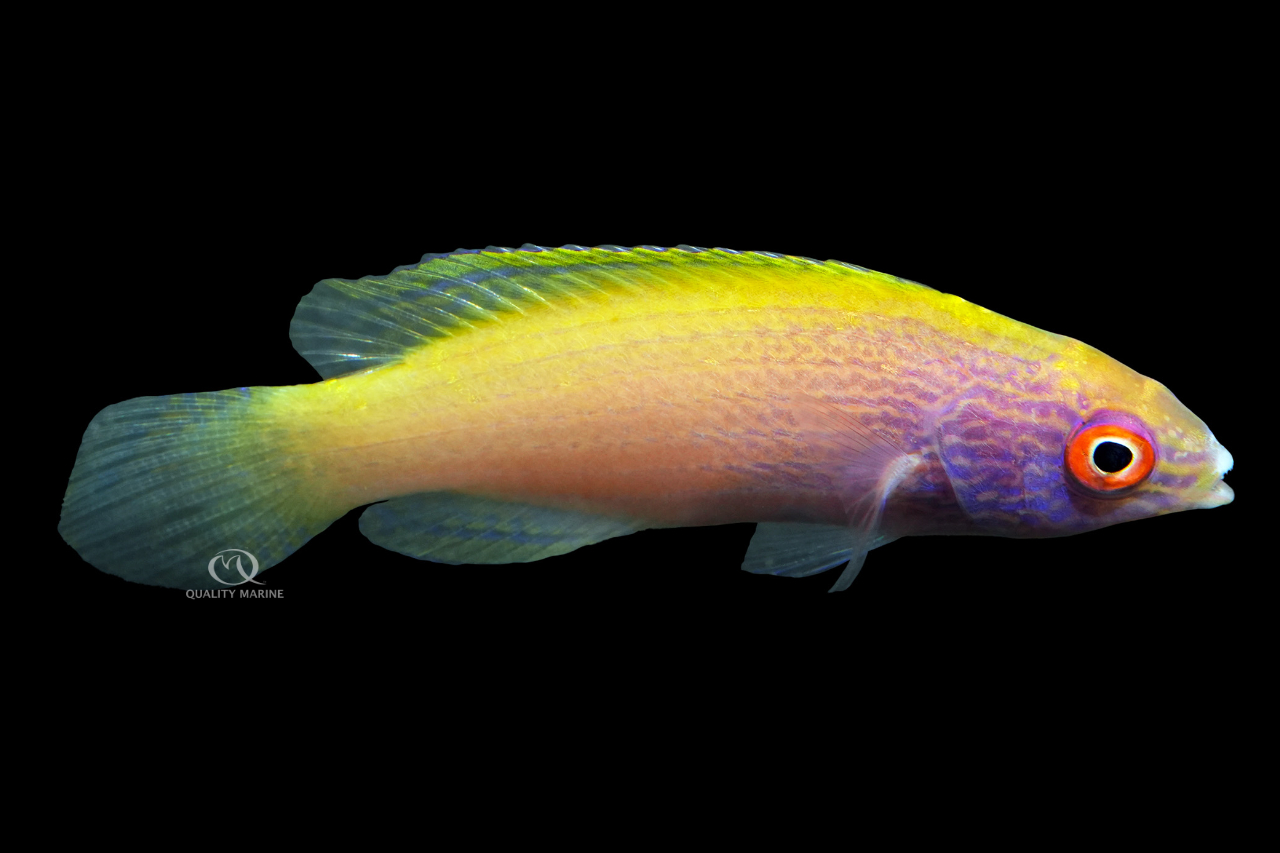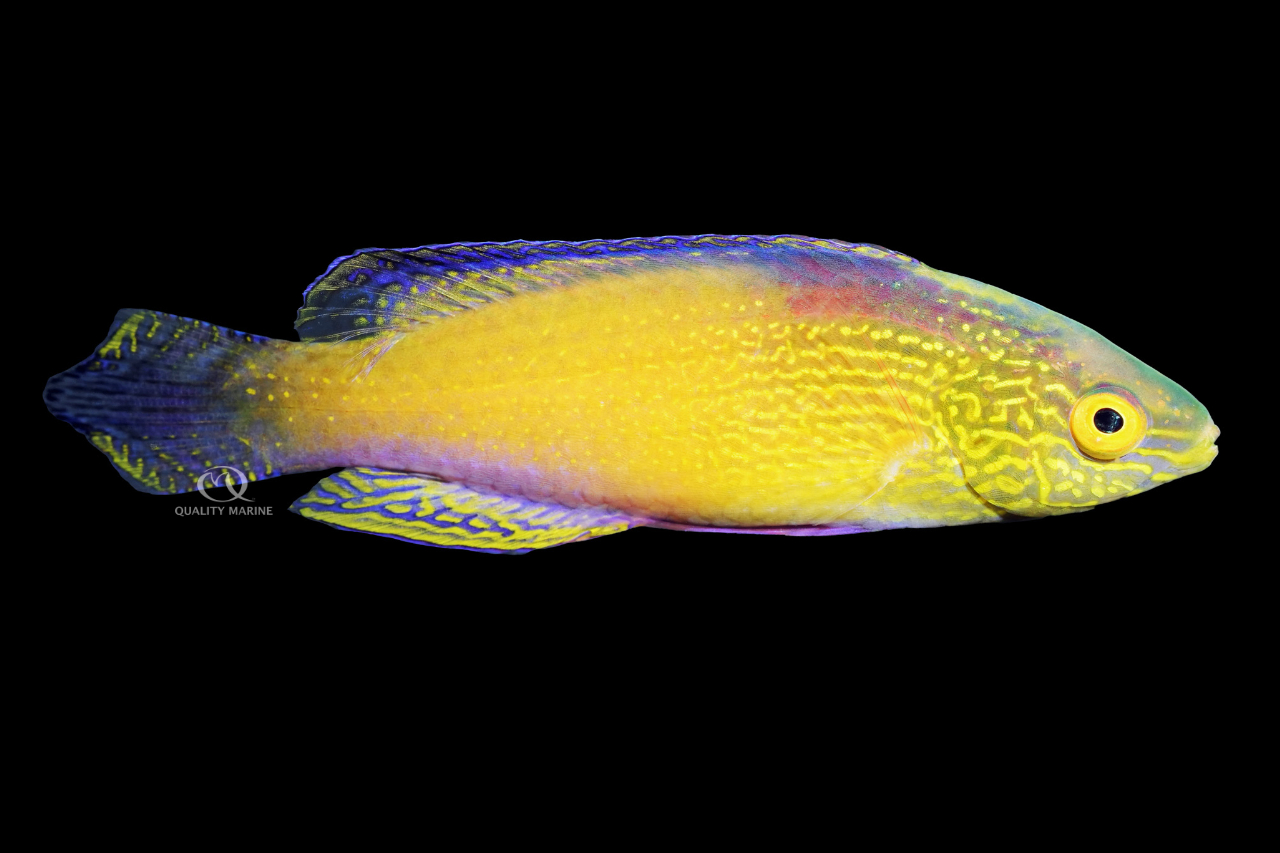Go For the Gold (Rhomboid)

There is a genus of fish named Cirrhilabrus, and every fish in it belongs on a list of the most beautiful, aquarium appropriate, peaceful fish available to the marine aquarium enthusiast. Few fish can rival them for their flashy colors and fins, let alone their activity (once acclimated). This genus is huge, and unsurprisingly, some of them are rare, some less so; some of them are gorgeous, and some are even more so. If you get a few of us fish geeks in a room, we're unlikely to all pick the same favorite, but we can mostly agree that the Golden Rhomboid Wrasse (Cirrhilabrus rhomboidalis) belongs high in the top ten list.
Sometimes they're just called the Rhomboid Wrasse, and sometimes they get called the Golden Fairy Wrasse, or Rhomboid Fairy Wrasse as all the fish in the Cirrhilabrus genus are often referred to as Fairy Wrasses. In the Central Pacific where they come from, they are also called Diamondtail Wrasses.
In that native range, they're usually found in large congregations, off reef edges in deep water ranging from 100ish feet down to over 300. In these larger groups, there are smaller congregations where one male will defend several females from other males in a group called a harem, this distribution will also work in the home aquarium, though we suggest keeping only one male unless the aquarium is large; depending on the size of the tank, this one male could look after up to six females (making a group of seven). Conversely, you could keep them as a pair as well, and occasionally, “mated” pairs are offered. No matter what the distribution is, we suggest adding them all at the same time.

Here's a juicy tidbit for you. Cirrhilabrus Wrasses are hermaphrodites. They're all born essentially sexless, and then segue into females when they're about a half inch long. In a group missing a dominant male, one of the females can then turn into a male. If an aquarist was patient, you could buy a group of females and with good husbandry and time, the group may produce a male for you! That being said, it's going to be easier, much faster, (not to mention a surer thing) just to buy the distribution you want. You'll usually see Rhomboid Wrasses in three grades, the least expensive of the three is female / juvenile, and this is because they are usually the smallest, and the least ornate. This isn't to say they won't be pretty, because they are, but they pale in comparison to the males, which are the next grade up. As a result of their extravagance, expect males to be more expensive than the females. Care is the same for both, truly the only difference is how many you can keep in a tank, and how they look. There is one more grade of Golden Rhomboid that you can aspire toward, and it is in hushed tones that we reveal to you, the Super Male. These are dominant males, fully developed and generally in breeding condition. They will be the largest, most ornate, and most expensive of all the grades. The standard Male grade can become the Super Male grade in your tank. They will only do this in the presence of female fish for the Super Male to impress, and in addition they need an excellent, protein rich, diverse diet.
All Cirrhilabrus Wrasses are very active and need multiple feedings a day; in house, they get two feedings per day, and if you wanted to, more meals wouldn't hurt as long as you fed less per feeding. As plankton feeders, Rhomboids are used to taking food out of the water column, and it is usually very easy to get them to eat in the home aquarium. The only real challenge is that they are shy when initially placed in a tank and so may hide during mealtimes. A portion of their diet should be a high-quality pellet; here we use the Nutramar Complete Sinking Pellet, and these are perfect. They also get fed a mix of meaty food, all from Gamma Foods. We vary the meaty part of their diet, and it will be a mix of stuff like Mysis, a variety of gut loaded Brine, Copepods, Finely Chopped Mussel and Prawn etc.

One of the nicest things about Golden Rhomboid Wrasses is that they aren't hard to keep. They don't need a huge tank, and a single male could be kept in a tank as small as 55 gallons, though as we've touched on, we suggest keeping the male with at least a couple females, and to do this, a 75- or 90-gallon tank might be more appropriate. They will do great in tanks with a lot of hiding places, which will make them bolder. It is hard to have too much flow, and they don't require a substrate. You should cover the display. These fish can hit an incredible speed over short distances when startled, and if this happens in the wrong direction, they could easily end up on the floor, which would be a tragedy! Lighting wise they aren't picky, but they should be acclimated to very bright light slowly.
In addition to the myriads of other amazing attributes of Cirrhilabrus rhomboidalis, they are the picture of “reef safe” and are super low risk with all of your corals, clams, cleanup crew and any other inverts you can think of. They are super peaceful too and so aren't going to bother any other fish unless you have too many male Cirrhilabrus in too small of a space. You should avoid fish like large Damsels, Triggers, Puffers and or other fish that might bully or pick on the Wrasse(s). In big enough aquariums, say over 125 gallons, when more than one male Fairy Wrasse is added to a tank, only one of these males is likely maintain the Super Male coloration, even if they are from different species. We also caution against keeping them with large, potent anemones like those from the Stichodactyla genus for the same reason that we recommend covering your tank. If a startled wrasse bolts, and it ends up in the anemone, the nem gets an expensive meal. We've seen this happen, it's a real possibility.
Long story short, Cirrhilabrus is a genus of wrasses that contains dozens of species, nearly all of which are gorgeous, reef safe fish that are small in stature, and peaceful with tankmates. Every one of these goes through the same development phases and so are usually available in the three grades we've touched on in this article. Among these wrasses, the Golden Rhomboid is among the most beautiful and certainly most sought after. They are definitely a showpiece fish; they have no real challenges in regard to keeping them. If you're ready for your dream fish, ask your LFS about getting you a harem of Golden Rhomboid Wrasses from Quality Marine today!